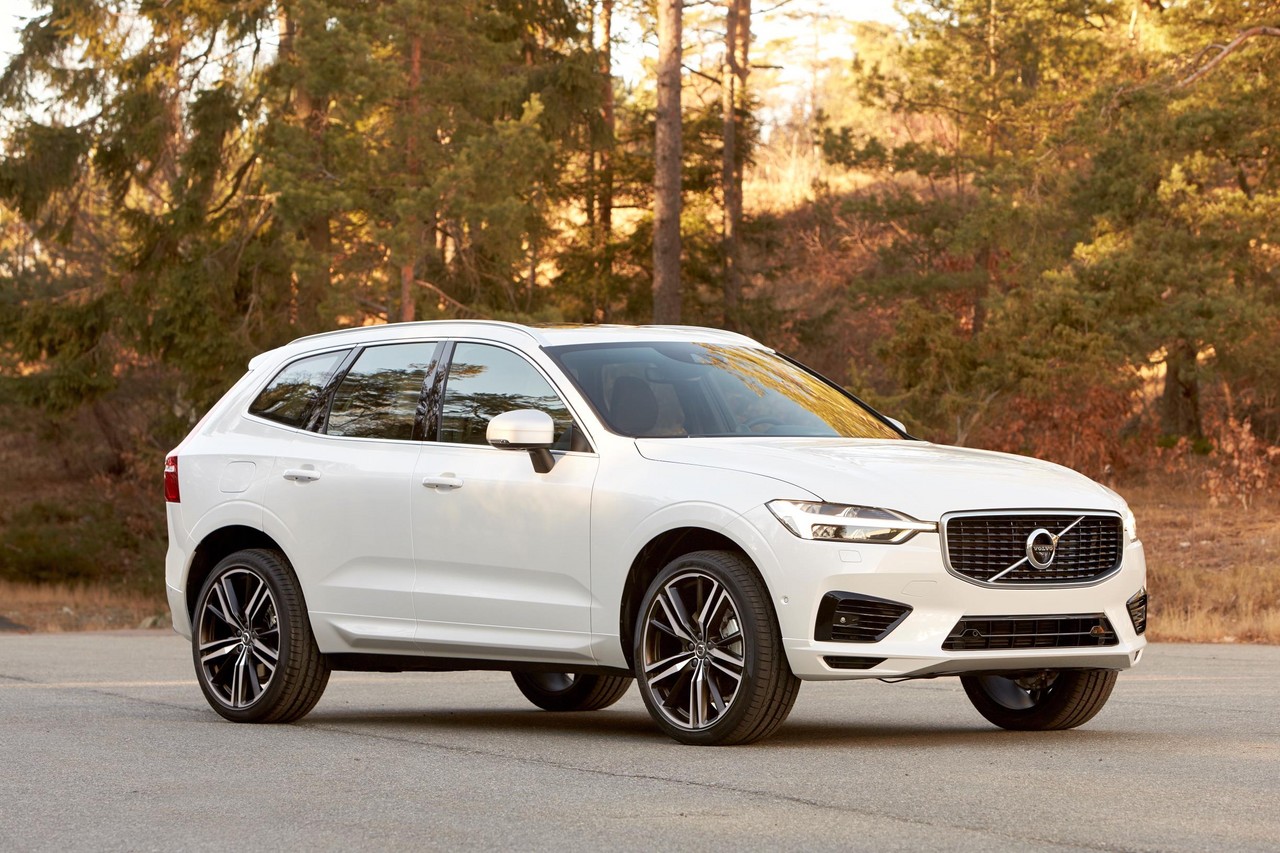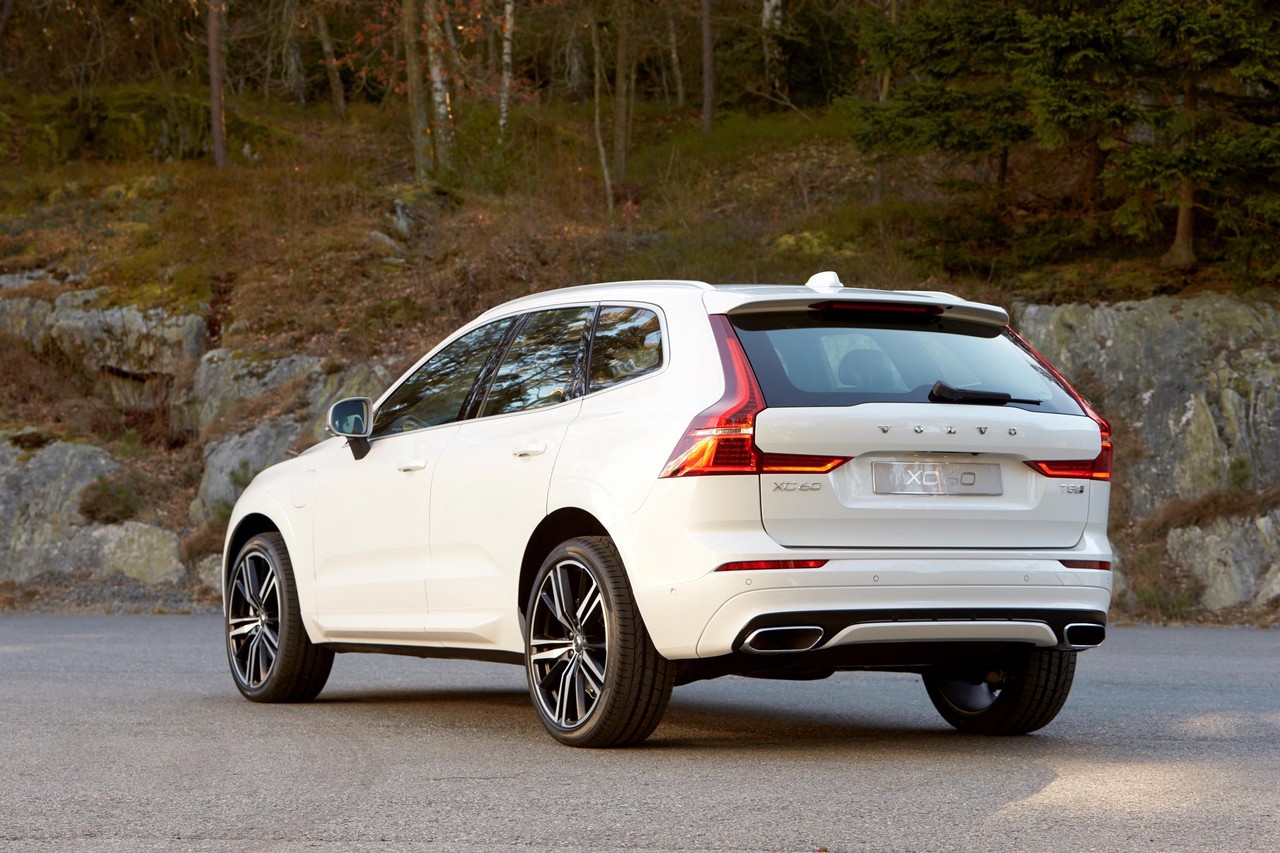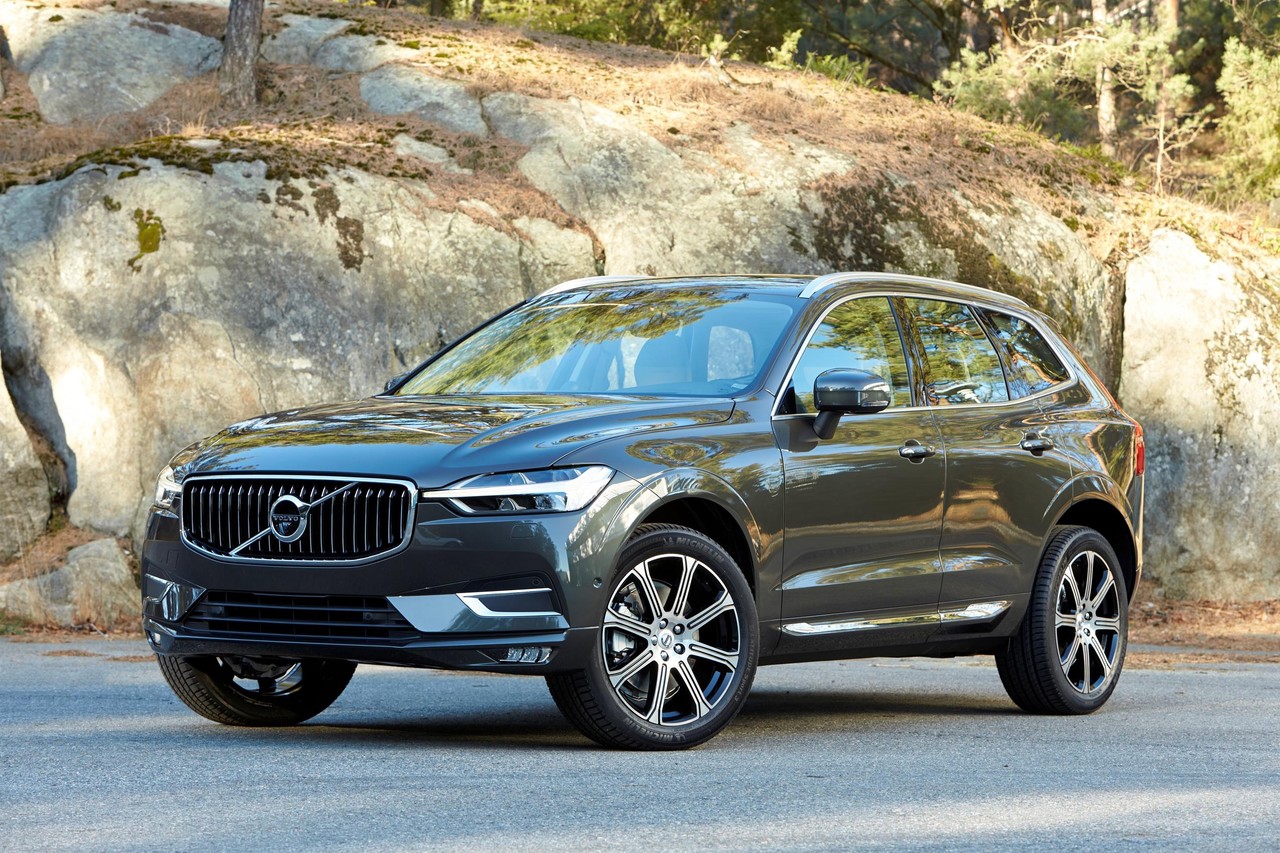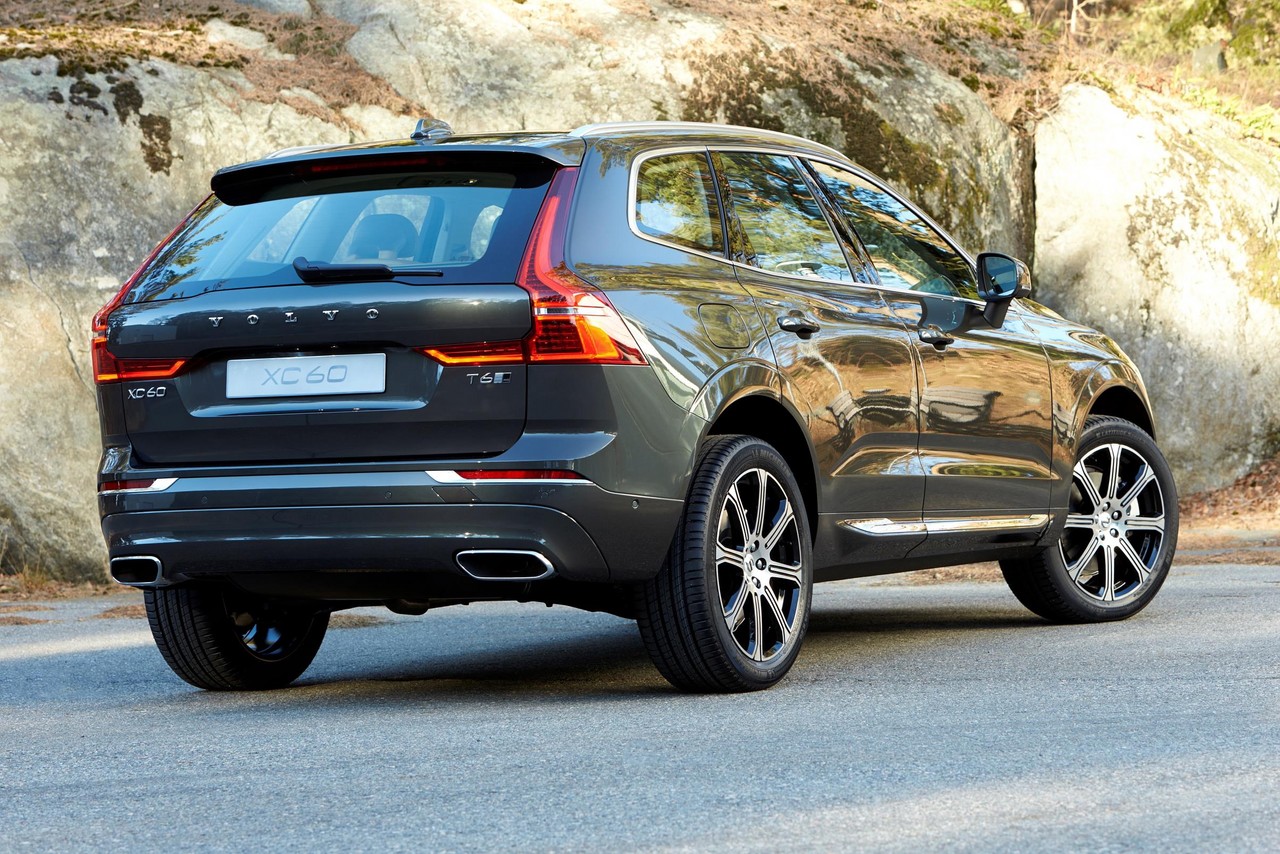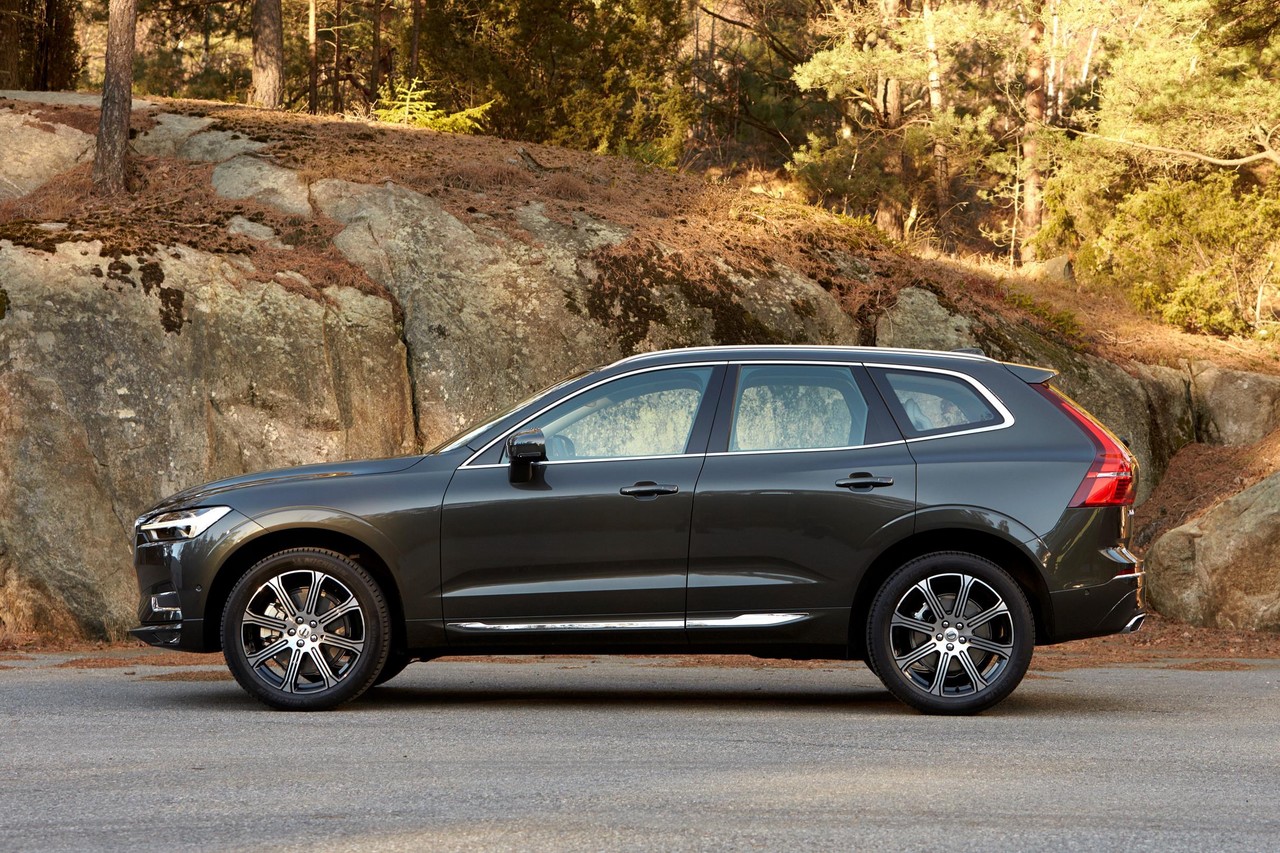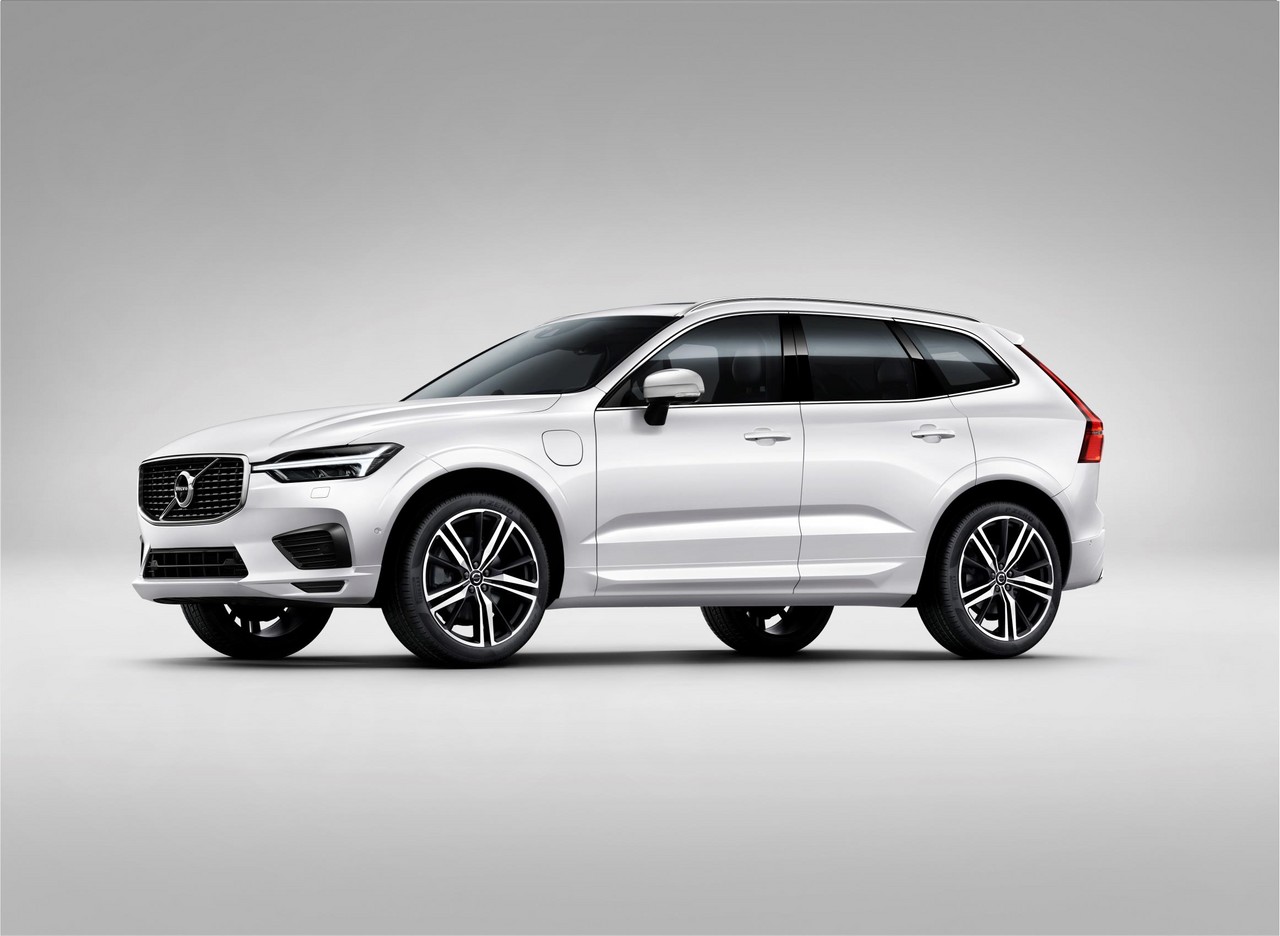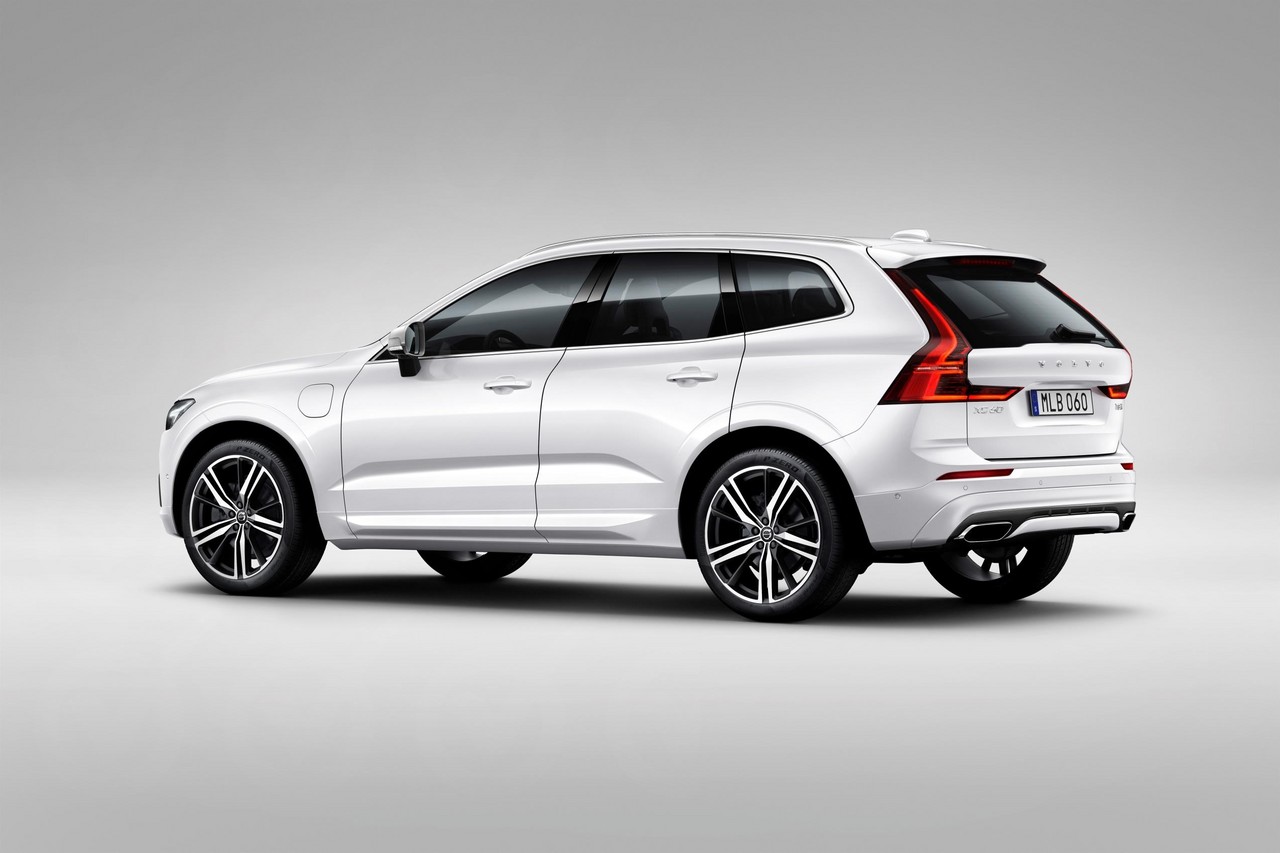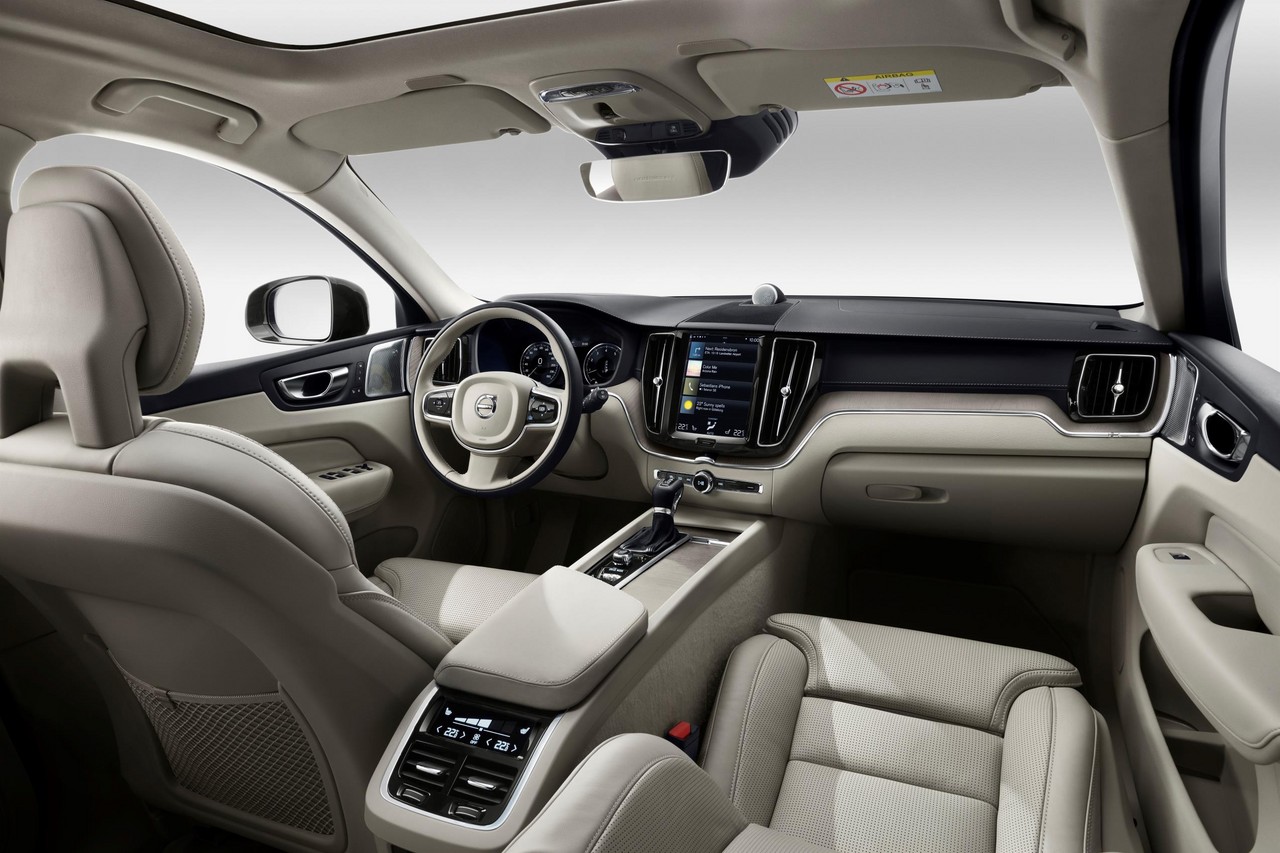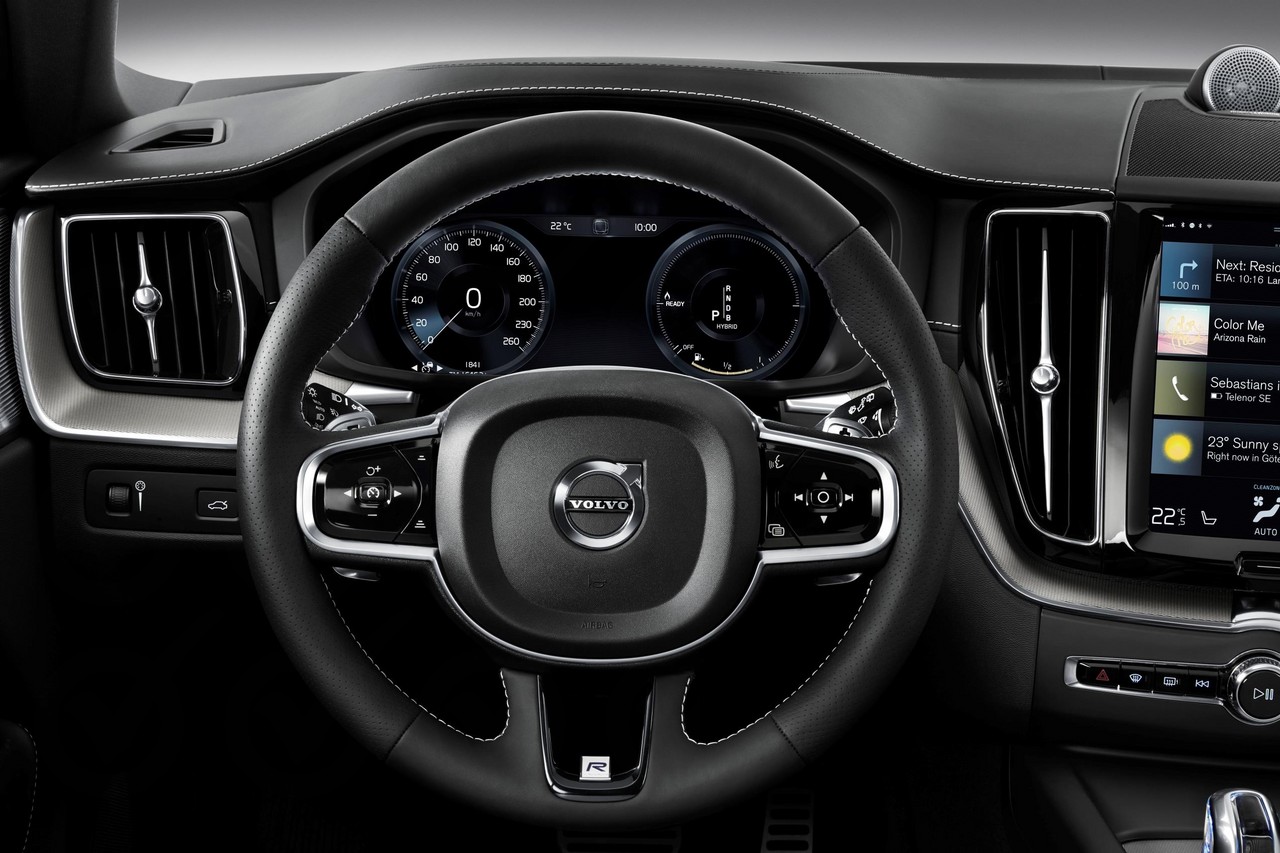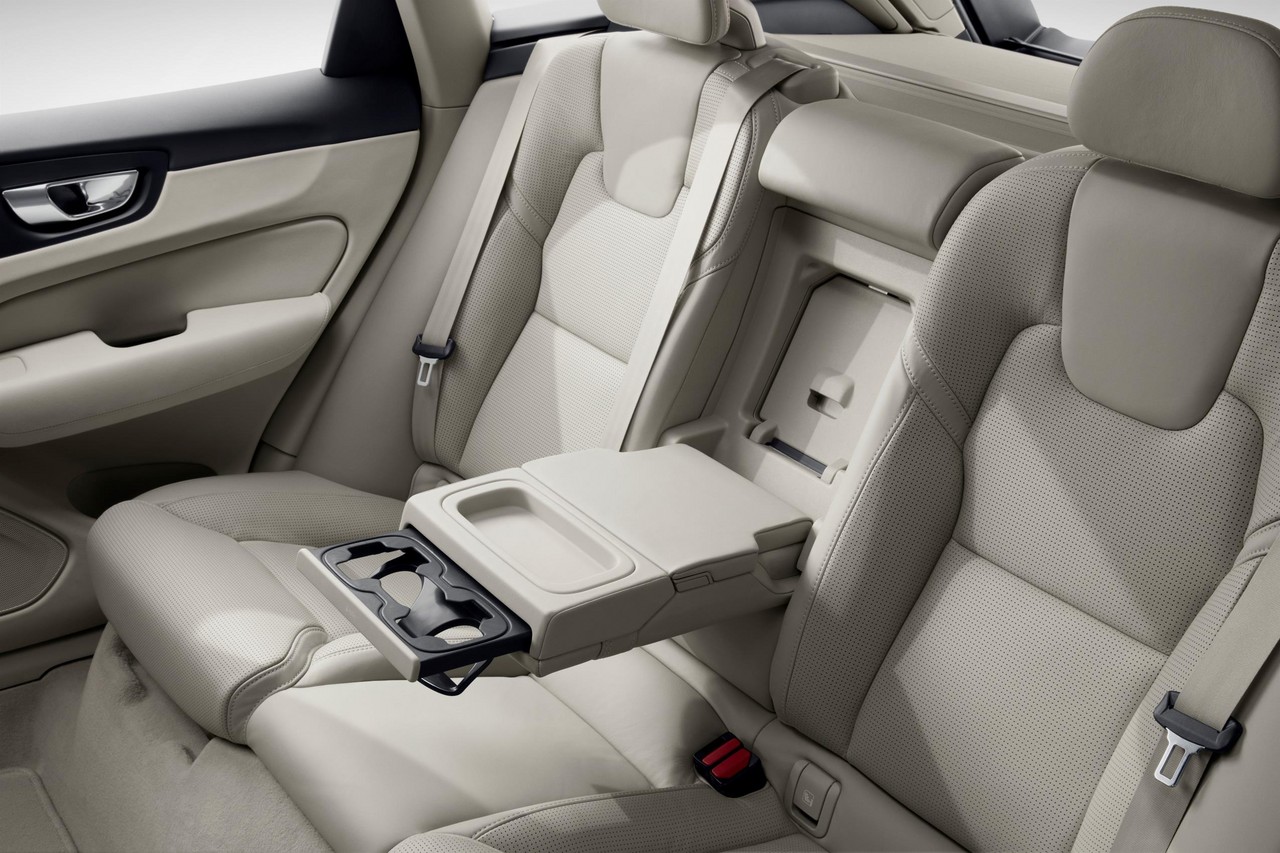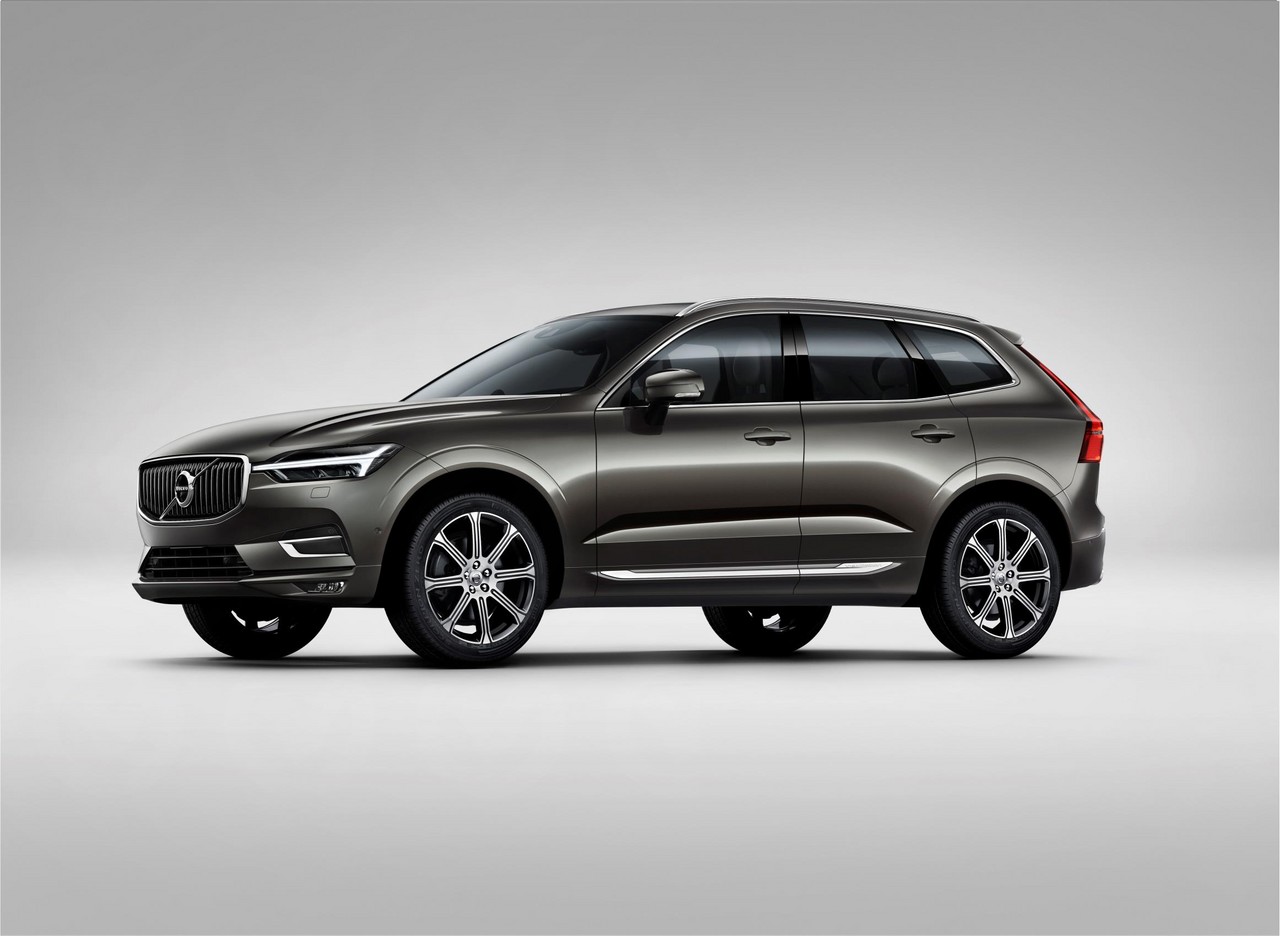
- Active safety technologies fitted as standard
- Supportive front seats
- Spacious interior has a high standard of fit and finish
- Quiet, well-insulated cabin
- Fuel-efficient powertrains
- Overly assisted steering lacks feel
- Poor bump absorption on low profile tyres
- Eight-speed automatic transmission hesitant when accelerating from rest
- Infotainment system has small keypad
- Less luggage space (505 litres) than some rivals
- Spongy brake pedal
Overview
Commencing production in April 2017 and released in Australia in October 2017, the Volvo XC60 was a mid-size SUV with five seats. Manufactured at Volvo’s Torslanda plant in Gothenburg, Sweden, the all-wheel drive Volvo XC60 range consisted of T5, T6, T8, D4 and D5 variants (see table below), all of which had eight-speed Aisin Warner automatic transmissions fitted as standard. Beyond the engine-based variants, the Volvo XC60 range consisted of Momentum, Inscription and R-Design editions.
| Variant | Engine | Trans. | Peak power | Peak torque |
|---|---|---|---|---|
| T5 AWD | 1969 cc B4204T23 turbo petrol I4 | 8sp auto | 187 kW at 5500 rpm | 350 Nm at 1500-4800 rpm |
| T6 AWD | 1969 cc B4204T27 turbo and super charged petrol I4 | 8sp auto | 235 kW at 5700 rpm | 400 Nm at 2200-5400 rpm |
| T8 AWD | 1969 cc B4204T35 turbo and super charged petrol I4 | 8sp auto | 235 kW at 5700 rpm | 400 Nm at 2200-5400 rpm |
| Electric motor | 65 kW | 240 Nm at 0-3000 rpm | ||
| Combined | 300 kW | 640 Nm | ||
| D4 AWD | 1969 cc D4204T14 turbo diesel I4 | 8sp auto | 140 kW at 4250 rpm | 400 Nm at 1750-2500 rpm |
| D5 AWD | 1969 cc D4204T23 turbo diesel I4 | 8sp auto | 173 kW at 4000 rpm | 480 Nm at 1750-2250 rpm |
Haldex all-wheel drive (AWD) system
The Volvo Mk.2 XC60 had a fifth-generation Haldex all-wheel drive system which consisted of an electronically controlled and hydraulically actuated multi-plate clutch coupling (located in front of the rear axle differential at the end of the prop shaft). Under low loads or when coasting, the rear axle was decoupled to reduce fuel consumption. If, however, there was a loss of front wheel traction or such a loss was anticipated by on-board sensors, then an electrohydraulic oil pump applied pressure to the clutch plates to transfer up to 50 per cent of the engine’s torque to the rear wheels (for a 50:50 front:rear torque split).
Body and dimensions
The Volvo Mk.2 XC60 was underpinned by Volvo’s ‘Scalable Product Architecture’ (SPA) which was shared with the 2015 Volvo XC90 , 2016 Volvo S90 and 2017 Volvo V90 Cross Country . Compared to the Volvo Mk.1 XC60 , however, the Volvo Mk.2 XC60 was 61 mm longer (at 4688 mm), 11 mm wider (1902 mm), 55 mm lower (1658 mm) and had a 91 mm longer wheelbase (2865 mm). Furthermore, the Volvo Mk.2 XC60 has a drag co-efficient of 0.32 Cd, and kerb weights ranged from 2081 kg to 2349 kg depending on variant.
Suspension
The Volvo Mk.2 XC60 had double wishbone front suspension with coil springs and an integral rear axle with transverse composite leaf springs. As an extra-cost option ($2490 at launch), the XC60 was available with Volvo’s ‘Active Four-C Chassis’ which included adaptive dampers (front and rear) and electronically-controlled air suspension. For the ‘Active Four-C Chassis’, the driver could select from five different modes; the air suspension also reduced the ride height at high speeds for improved aerodynamics and stability
Steering
The Volvo XC60 had rack-and-pinion steering with speed-sensitive, electric power assistance; the steering wheel required 3.0 turns from lock to lock, while the XC60 had a turning circle of 11.4 metres.
Safety equipment
Standard safety equipment for the Volvo Mk.2 XC60 included dual front airbags, a driver’s knee airbag, front seat-mounted side airbags, full-length curtain airbags (i.e. for front and rear occupants), ABS, electronic brake force distribution, brake assist, electronic stability control, traction control and front seatbelts with pre-tensioners and load limiters.
For the Volvo XC60, Volvo’s ‘City Safety’ system was fitted as standard and active at speeds above 4 km/h. City Safety included collision avoidance or mitigation with –
- Other vehicles: for vehicles in front of the Volvo XC60, the driver received a warning followed by autonomous braking if the driver did not brake or steer to avoid the vehicle ahead. At speed differences up to 50 km/h between the XC60 and the vehicle ahead, the collision could be avoided even if the driver did not react. At higher speed differences, however, the autonomous braking of the XC60 only reduced the severity of the collision. If a collision was imminent and the XC60 was travelling above 30 km/h, the front seatbelts were tightened;
- Cyclists: if a cyclist swerved into, crossed or was stationary in the path of the Volvo XC60, City Safety warned the driver and would initiate autonomous braking if the driver did not apply the brakes;
- Oncoming vehicles in intersections: if the driver turned in front of an oncoming vehicle, City Safety could assist by braking autonomously if the driver failed to do so. If a collision was imminent and the XC60 was travelling above 10 km/h, the front seatbelts would be tightened;
Pedestrians: if a pedestrian moved into, crossed or was stationary in the path of the Volvo XC60, the driver would be warned and the brakes would be applied autonomously if the driver failed to do so (operating at speeds up to 70 km/h). A collision with a pedestrian could be avoided at speeds of up to 45 km/h; and, - Large animals: for the XC60, the radar/camera unit could detect large animals – such as moose, elk and deer – that were either on the road or about to cross it. The driver received an initial warning and, when braking, additional brake pressure could be provided to support avoidance if needed. If the driver did not respond, however, the brakes would be applied autonomously. According to Volvo, autonomous braking when large animals were detected could result in vehicle speed being reduced by 15 km/h. If a collision was imminent and the XC60 was travelling at speeds above 30 km/h, the front seatbelts would be tightened.
As standard, the Volvo XC60 was also fitted with the following active safety technologies –
- Oncoming Lane Mitigation (OLM): active at speeds between 60 km/h and 140 km/h, OLM helped drivers avoid collisions with vehicles in an oncoming lane. The system worked by alerting a driver who had unwittingly departed from their lane and provided automatic steering assistance to guide them back into their lane;
- Run-Off Road Protection: if the XC60 departed from the road, the front seatbelts would be automatically tightened. To prevent spinal injuries, Volvo developed an energy-absorbing function between the seat and seat frame which would deform mechanically to cushion the vertical forces that could occur when a vehicle encountered a hard landing;
- Lane Keeping Aid: used cameras to monitor the XC60’s position in its lane and provided an audible warning if the XC60 was about to depart from its lane without the turn indicators having been applied. The Lane Keeping Aid function could also apply corrective steering to return the XC60 to the centre of its lane;
- Driver Alert Control: monitored driving behaviour for fatigue and, if detected, sounded a warning tone and displayed a message encouraging the driver to take a break; and,
- Volvo’s ‘IntelliSafe Surround’ technologies:
- Blind Spot Information System (BLIS): used rear radar sensors to detect vehicles approaching the rear of the XC60 from seventy (70) metres away and would alert drivers to their presence. For the XC60, BLIS includes a ‘steer assist’ function that steers the vehicle back into its lane;
- Cross Traffic Alert (CTA): rear radar sensors would alert the driver to crossing traffic – up to 30 metres from the sides of the vehicle – when reversing out of a parking space; and,
- Rear Collision Mitigation: used a rearward facing radar to detect if a rear impact is imminent and, if so, tightened the seatbelts to protect occupants and flashes the brake lights to warn the following driver.
The Volvo XC60 Inscription and R-Design were also equipped with Adaptive Cruise Control (ACC). When cruise control was active, ACC could automatically reduce vehicle speed if a vehicle was detected in the lane ahead and also accelerate back to the cruising speed when the road ahead cleared.
Pilot Assist: XC60 Inscription and R-Design
For Australia, the Volvo XC60 Inscription and R-Design editions were equipped with Volvo’s ‘Pilot Assist’ which assisted with acceleration, braking and steering functions to help the driver follow the traffic flow within their lane. According to Volvo, this assistance reduced driver strain and increased safety margins by enhancing distance keeping and positioning within the lane. For the Volvo XC60, the second generation Pilot Assist system provided steering assistance at speeds up to 130 km/h and did not need a vehicle ahead to follow where road markings were clearly defined.
The Pilot Assist system was limited in the extent of acceleration, braking and steering force it could apply. As such, the driver remains responsible for the operation of the vehicle if Pilot Assist was active; Pilot Assist would also automatically switch off if the driver did not keep their hands on the steering wheel. The driver could over-ride Pilot Assist at any time by using the brake pedal, accelerator pedal or steering wheel. Furthermore, using the lane change indicator turned off steering support. Pilot Assist could be activated via the steering wheel buttons on the left side of the wheel.
Euro NCAP testing
In Euro NCAP testing , the Volvo Mk.2 XC60 received a five star safety rating which included a 98 per cent adult occupant protection rating, an 87 per cent child occupant protection rating and a 95 per cent ‘safety assist’ rating. In the frontal offset test, protection of both front occupants was generally rated as good, though protection of the driver’s lower legs was rated as adequate (i.e. a slight risk of serious injury). In the side impact and pole tests, however, maximum points were awarded.
Features: Volvo XC60 Momentum (D4 and D5)
Standard features for the Volvo XC60 Momentum editions included 7.5J x 19-inch alloy wheels with 235/55 R19 tyres, a 330 watt audio system with ten speakers, digital radio tuner (DAB), auxiliary (3.5 mm) and USB inputs, smartphone integration via USB (iPhone and Android), Bluetooth mobile phone connectivity and audio streaming, navigation system with 12.3-inch display, power adjustable ‘Comfort’ front seats with driver’s seat memory settings, leather upholstery, dual-zone climate control air conditioning, LED headlights with integrated high pressure cleaners and Volvo’s ‘Active High Beam’ (i.e. automatic switching between low and high beam), front fog lights, dusk-sensing headlights, rain-sensing wipers, 60/40 split folding rear seats, remote central locking with proximity key, power adjustable and heated door mirrors, power windows, a height and reach adjustable steering column, push-button start, an electric parking brake, 12 volt power sockets (in the front and rear consoles), handsfree tailgate opening and closing, driver memory settings (for the driver’s seat), floor mats, ‘Iron Ore Aluminium Decor’ interior inlays, illuminated vanity mirrors, ambient lighting, integrated roof rails, indirect tyre pressure monitoring, a trip computer, an alarm and immobiliser.
As standard, the Volvo XC60 was also equipped with –
- Park Assist Pilot: provided automated steering for parallel and perpendicular parking manoeuvres while the driver controlled vehicle speed; and,
- Virtual Park Assist 360�: during low speed manoeuvres, Virtual Park Assist 360� used four cameras to display a bird’s eye view of the vehicle on the central touchscreen.
Features: Volvo XC60 Inscription (D4 and D5)
Compared to the XC60 Momentum, the XC60 Inscription editions were further equipped with 8.0J x 20-inch black alloy wheels with 255/45 R20 tyres, four-zone climate control air conditioning, a cooled glovebox, a head-up display and ‘Driftwood Decor’ interior inlays. Visually, the XC60 Inscription editions could be identified by their ‘bright decor’ side window trim and dual integrated tailpipes.
Features: Volvo XC60 R-Design (D5, T6 and T8)
The range-topping Volvo XC60 R-Design was distinguished by its 8.5J x 21-inch matt black alloy wheels with 255/40 R21 tyres, ‘R-Design’ sport seats with Nubuck textile and Fine Nappa perforated leather upholstery, an air-ventilated subwoofer, ‘Contour’ front seats, an ‘R-Design’ steering wheel with perforated leather trim and gearshift paddles, ‘Metal Mesh Decor’ interior inlays, ‘R-Design’ textile carpet mats and alloy pedals. The Volvo XC60 T8 Twin Engine was further equipped with a panoramic sunroof, but omitted front fog lights, four-zone climate control air conditioning and the cooled glovebox; instead, it had dual-zone climate control as per the XC60 Momentum editions.
Visually, the Volvo XC60 R-Design editions could be identified by their ‘silk metal decor’ side window trim.
Specifications
- Specifications and features: Volvo Mk.2 XC60 (October 2017)
- Technical specifications: Volvo Mk.2 XC60 (March 2017)
